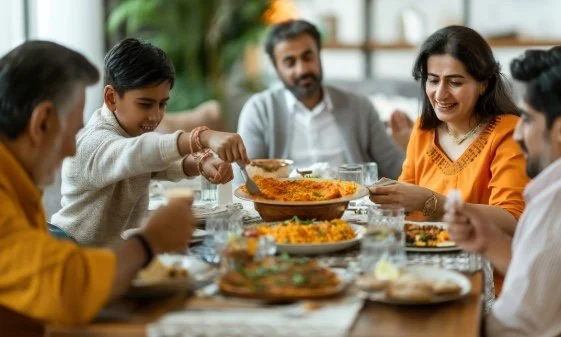National Survey Finds Indian Diets Too Heavy on Refined Carbs
ICMR Links Food Choices to Rising Diabetes, Obesity, Protein Deficiency
October 14, 2025
India’s largest-ever nutrition and metabolic health survey has found that 62% of daily calories in Indian diets come from carbohydrates, most of them of poor quality. The finding suggests that the country’s food systems, policies and poverty conditions are pushing people toward diets that increase their risk of diabetes and obesity, not protect against them.
The study by the Indian Council of Medical Research (ICMR) covered 121,000 (1.21 lakh) adults across all 36 states and Union territories, including Delhi. It collected detailed dietary data from both urban and rural populations, giving a national picture of what people eat and what metabolic risks are associated with those patterns.
It found that carbohydrates account for an overwhelming share of the Indian diet. Nearly two-thirds of calories come from carbs, with most of these being refined grains such as white rice and wheat flour, along with added sugars, as reported by NDTV. The study also found that the carbohydrate sources vary across regions: white rice dominates diets in the South, East and Northeast, while wheat is more common in the North and Central states. Millets are consumed widely only in a few states like Karnataka, Gujarat and Maharashtra.
The carbohydrate-heavy diet is linked with serious metabolic risks. The study found a 15 to 30% higher likelihood of type 2 diabetes, prediabetes, and both general and abdominal obesity in people whose diets had high carbohydrate content. Even among those who substituted white rice with whole wheat or millets, the benefits were limited when total carbohydrate intake stayed high. The reason lies in food processing. Grinding grains into fine flour makes them digest faster, which raises blood sugar quickly, even if the grain was healthy to begin with.
The study also pointed to an insufficient intake of proteins. Just 12% of calories in Indian diets come from protein, well below the recommended 15%. Of that, the overwhelming majority is plant-based. Dairy accounts for only 2%, and animal protein just 1%. This protein gap has serious implications for muscle health, growth in children and overall metabolic function. Simultaneously, 21 states and Union territories were found to exceed the recommended limit for added sugar, consuming more than 5% of daily calories from it.
On fats, the overall quantity of intake remained within suggested limits, but the quality of fats consumed was poor. People in most parts of India eat too much of the wrong kinds of fats, like those found in fried snacks and processed foods, and too little of the healthy ones, such as those found in fish, nuts and seeds. This mix raises the risk of heart disease and other health problems linked to poor diet.
What this study makes clear is that India’s food security and public nutrition programmes have historically prioritised quantity over quality. The public distribution system (PDS), for instance, continues to supply white rice and wheat as staples, pushing large populations to depend on refined grains. There is no meaningful push to integrate more nutritious alternatives like unpolished millets or legumes (foods like lentils, beans, peas and chickpeas, or the dals and pulses people eat every day in Indian homes) into these systems at scale. This has normalised a high-carb, low-protein diet among the poor.
Moreover, national dietary guidelines have not kept pace with the shift in disease burden. While undernutrition is still a concern in several districts, India’s growing crisis is now one of metabolic disorders, including diabetes, obesity and heart disease, fuelled by poor diet quality. Yet, there is no coherent national policy that connects agriculture, food subsidies, school meals and healthcare with a metabolic health agenda.
The research also reveals how misleading common food substitution advice can be. Simply switching from rice to wheat or millets does little if those grains are still processed and consumed in large quantities.
What is also concerning is the near absence of institutional support for improving fat quality in diets. While saturated fats (the kind found in butter, ghee, red meat and many fried or packaged foods) are routinely used in processed foods and cooking oils, few public initiatives educate people about healthier alternatives or make them accessible. Similarly, the low intake of animal proteins among large sections of the population is not being addressed either through cultural awareness or affordable availability.
The Ministry of Consumer Affairs, Food and Public Distribution should immediately initiate reforms in the PDS, phasing out milled grains and replacing them with unpolished millets, pulses and other whole foods. These reforms must also ensure affordability, so that poorer households are not penalised for choosing healthier options. Alongside, the Ministry of Health and Family Welfare must integrate metabolic risk prevention into primary healthcare by training health workers to offer dietary advice tailored to local habits and risks.
The ICMR and the Food Safety and Standards Authority of India should jointly launch a nationwide awareness campaign that focuses on explaining how food processing, portion size and fat quality affect metabolic health. They should also work with state governments to revise school meal programmes and anganwadi food provisions to ensure that meals contain balanced macronutrients, especially proteins and good fats, and do not rely solely on carbohydrates.
You have just read a News Briefing by Newsreel Asia, written to cut through the noise and present a single story for the day that matters to you. Certain briefings, based on media reports, seek to keep readers informed about events across India, others offer a perspective rooted in humanitarian concerns and some provide our own exclusive reporting. We encourage you to read the News Briefing each day. Our objective is to help you become not just an informed citizen, but an engaged and responsible one.

